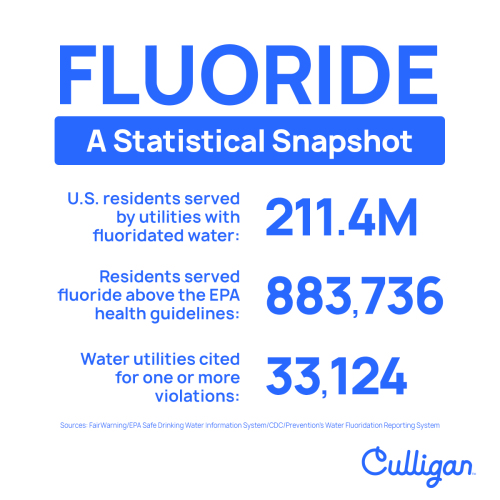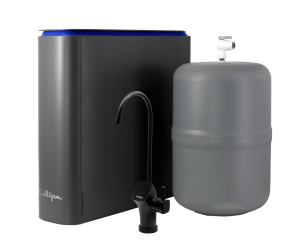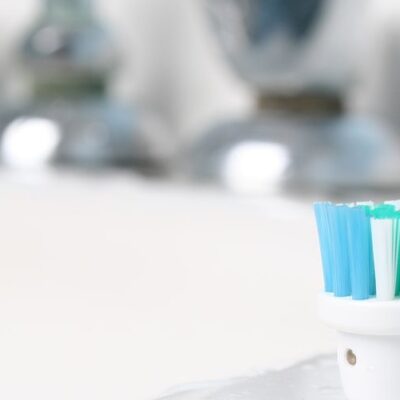How Much Fluoride Is In Clearwater, Largo, Port Richey, and St. Petersburg Water?
Fluoride levels detected in water throughout the these four areas of The Gulf Coast average around 0.65 parts per million (ppm). This level falls within the recommended range for promoting dental health without causing adverse effects.
However, individual sensitivity to fluoride and cumulative exposure from various sources should be considered when evaluating the safety of your tap water. Testing your specific water supply can provide more accurate results tailored to your home’s water quality.
Why Is Fluoride in America’s Water Supply?
The introduction of fluoride into water supplies dates to 1945 in Grand Rapids, Michigan, marking the inception of a practice known as fluoridation. This process involves adding fluoride to municipal water supplies, with concentrations ranging between 0.7 and 1.2 ppm, a range considered both safe and effective for dental health. Notably, the 0.7 ppm concentration is widely acknowledged as the safest level, providing the optimal range for preventing tooth decay.
Revisions to Acceptable Fluoride Levels
Many communities are taking a second look at fluoridation levels and motivations, and as the debate continues, it’s a good idea to know some basics about fluoride and its legacy in this country.
In 2015, the U.S. Department of Health and Human Services Agency (HHS) revised what defined acceptable fluoride levels:
“…water systems practicing fluoridation adjust their fluoride content to 0.7 mg/L (parts per million), as opposed to the previous temperature-dependent optimal levels ranging from 0.7 mg/L to 1.2 mg/L. There is no change regarding federal health officials’ strong and long-standing support regarding the value of fluoridation of drinking water.”
Florida’s 2025 Ban on Fluoride in Tap Water
Despite the CDC’s strong backing of adding fluoride to drinking water, this practice is not without its critics.
As of April 30th, 2025, Florida is poised to become the second state in the country to pass a bill that would ban fluoride in public drinking water. This is due to recent studies that have linked increased fluoride consumption in pregnant women to reduced IQ levels in their children.
Although the Florida bill doesn’t mention fluoride by name, it prohibits local governments from adding substances to drinking water for any reason other than meeting established water quality standards. Supporters describe the bill—which also includes restrictions on plant-based food labeling—as a broad consumer protection measure.
“Anything that relates to water quality, removing contaminants, things like that, we’re not touching that,” state representative Kaylee Tuck said. “It’s anything that has to do with health. So fluoride, vitamins, whatever else it is.”

Why Should You Be Concerned About Fluoride Levels in Your Water?
While small amounts of fluoride in drinking water are considered safe and even beneficial for dental health, excessive fluoride exposure can cause problems. Dental fluorosis, a condition characterized by discoloration and damage to tooth enamel, is one of the most common issues. Chronic exposure to high levels of fluoride can also affect bones and joints, contributing to skeletal fluorosis.
Special populations such as infants, children, pregnant women, and individuals with certain health conditions may be more vulnerable to the adverse effects of fluoride. Research has suggested that elevated levels of fluoride exposure may have potential neuropsychiatric risks and may affect IQs in children. If you are concerned about your fluoride intake, it’s essential to test your water and take action if needed.
Solutions
Suggested Products

The Aquasential® Smart Reverse Osmosis Water Filter (RO)
- 7 stages of filtration and 12 filter options
- Certified for reduction of 58 contaminants
- 2-in-1 sediment and carbon filter screens out sediment and particles
- Can alert you and your dealer when service or filter replacements are needed
Benefits of Reducing Fluoride in Your Water
By removing excess fluoride from your water, you can:
Preventing Dental Fluorosis and Promoting Oral Health
One of the primary concerns associated with excessive fluoride consumption is dental fluorosis, which manifests as white spots, discoloration, or even pitting of the enamel on teeth. While moderate fluoride intake can aid in the prevention of cavities by strengthening tooth enamel, excessive exposure—especially during childhood when teeth are still developing—can lead to these unsightly and potential long-term cosmetic issues.
Promoting oral health requires a balanced approach to fluoride use. Ensuring that children consume the right amount of fluoride, primarily through dental products such as toothpaste and professionally administered treatments, is crucial. However, ingesting high levels of fluoride from drinking water, particularly where fluoride is artificially added, can tip the scales from beneficial to harmful. By using water filtration systems to reduce fluoride levels in tap water, families can take proactive measures to safeguard their children’s oral health, ensuring that they reap the benefits without facing the risks associated with overexposure.
Protecting Bone Health from Long-Term Overexposure
Long-term consumption of elevated fluoride levels can potentially affect bone health, leading to conditions such as skeletal fluorosis. This condition is characterized by a gradual accumulation of fluoride in the bones, which can result in stiffness, pain, and in extreme cases, changes to bone structure. While some fluoride is necessary for maintaining healthy bones, excessive amounts can disrupt the delicate balance required for optimal bone integrity.
Cutting down on fluoride intake through effective water filtration can mitigate these risks, especially for sensitive populations including pregnant women and young children whose bones are still developing. Protecting bone health is essential, as strong bones are crucial for mobility and overall health throughout life. With modern filtration methods, like Reverse Osmosis (RO), residents in The Gulf Coast area of Florida can ensure that their water is not only free from harmful contaminants but also safe from elevated fluoride levels, promoting long-term skeletal health and wellness.
Why and How You Can Remove Fluoride From Your Tap Water
If your home has fluoridated water and you’re concerned about it, there are water treatment methods available that specifically address and remove water additives like fluoride.
To determine how much fluoride is in your water, a professional water test is necessary. Culligan of The Gulf Coast offers comprehensive water testing services to accurately measure fluoride levels and identify other potential contaminants, such as radiological contaminants and organic compounds. After testing, we will provide a detailed report with clear recommendations for your home.
Reverse osmosis systems for example, are designed to remove hard-to-filter chemicals like fluoride, that many other filtration devices in big box stores and online retailers cannot. This advanced process uses a semipermeable membrane to trap even the smallest contaminants, delivering cleaner, safer drinking water.
Benefits of Fluoride in The Gulf Coast Area Tap Water
Clearwater, in addition to Largo, Port Richey and St. Petersburg, adhere to this range, with 0.66 ppm recognized as just below the safest and most effective level for preventing tooth decay (0.7 ppm). The area’s commitment to this optimal concentration reflects a meticulous balance between promoting dental health and addressing any potential concerns associated with higher fluoride levels.
Proven to protect teeth, fluoride counteracts acid produced by mouth bacteria from sugary foods. This acid weakens tooth enamel, increasing cavity risk. Fluoride rebuilds and strengthens enamel, preventing cavities and even restoring tooth surfaces.
Community water fluoridation adjusts water fluoride to recommended levels for decay prevention. While other fluoride products exist, water fluoridation is the most cost-effective, reducing tooth decay by 25% in all ages, according to the Centers for Disease Control and Prevention (CDC)
Benefits extend across ages. For children, fluoride strengthens developing adult teeth; for adults, it supports enamel, reducing cavities, severity, need for dental procedures, and associated pain and suffering.
FAQ’s About Fluoride
How Do I Know if My Water Has Too Much Fluoride?
The best way to determine fluoride levels in your water is through a professional water test. While public water systems provide annual reports, fluoride levels can vary based on your specific location, plumbing, and water source. The EPA’s maximum contaminant level for fluoride is 4.0 mg/L, but levels above 0.7 mg/L could contribute to fluorosis with prolonged exposure. Culligan of The Gulf Coast offers comprehensive water testing to accurately measure fluoride levels in your home’s water supply.
Is Fluoride in Drinking Water Safe for Infants?
Infants are more sensitive to fluoride because their developing teeth and bones absorb minerals differently than adults. The CDC and American Dental Association recommend using fluoride-free water for mixing infant formula if your water supply has added fluoride. Excess fluoride consumption during infancy can increase the risk of dental fluorosis, which appears as white spots or streaks on developing teeth. If you’re concerned, using a fluoride-free water source or an RO filtration system can help ensure safe drinking water for your baby.
Does Boiling Water Remove Fluoride?
No, boiling water does not remove fluoride. In fact, it can increase fluoride concentration because water evaporates, leaving the fluoride behind. Fluoride can be removed from water using reverse osmosis.
Can Brita Filters Remove Fluoride?
No, Brita filters do not remove fluoride. Standard carbon-based filters, like Brita and PUR, are designed to improve taste and remove chlorine and some heavy metals, but they do not filter out fluoride ions. If you want to reduce fluoride in your drinking water, you’ll need a reverse osmosis system.
How Does Fluoride Affect Pets?
Like humans, pets can be affected by excessive fluoride exposure. Since dogs and cats drink tap water and may consume fluoride from processed pet food, high fluoride levels can impact their health over time. Potential effects include:
- Dental fluorosis – in young pets during tooth development.
- Bone issues – increased risk of fractures or joint problems in older pets.
- Neurological effects – from excessive long-term fluoride consumption.
Using filtered water for pets, especially if your tap water has high fluoride levels, can help reduce the risk of overexposure.
What are Alternative Sources of Fluoride if I Remove it From My Water?
If you choose to remove fluoride from your drinking water, you can still get adequate fluoride for dental health through:
- Fluoridated toothpaste – recommended by dentists for cavity prevention.
- Fluoride treatments at the dentist – professional fluoride applications.
- Certain foods – seafood, tea, and some vegetables naturally contain fluoride.




Facebook